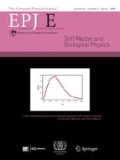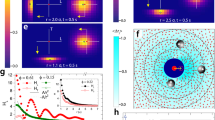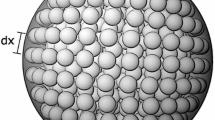Abstract.
In suspensions with charged particles, electrostatic forces and hydrodynamic interactions are both important to describe the system. We study different models of hydrodynamic interaction for monopolarly charged particles in a non-polar liquid. In this case, there is no screening of the Coulomb repulsion, so the repulsion between all pairs must be taken into account. The particles are expected to drift away from each other, however at a lower rate when hydrodynamic interaction between the particles is taken into account. Existing, frequently used models of hydrodynamic interactions tend to overestimate the slowing down of the charged particles, even to the extent that the particles effectively attract each other. This is demonstrated for some selected particle setups. We find that these anomalies even occur in dilute systems, if they contain sufficiently many particles. We explain why these anomalies can be avoided by an approach, in which the superposition of interactions is done in the friction tensor instead of the mobility tensor.
Similar content being viewed by others
References
S. McNamara, E.G. Flekkøy, K.J. Måløy, Phys. Rev. E 61, 4054 (2000).
J. Harting, A. Komnik, H.J. Herrmann, Lattice-Boltzmann Simulations of Transport Phenomena and Structuring in Suspensions, in Behavior of Granular Media, edited by P. Walzel, R. Grochowski, C.A. Krülle, S.J. Linz, Vol. 9 of Schriftenreihe Mechanische Verfahrenstechnik (Shaker Verlag, Aachen, 2006) p. 3.
A. Komnik, J. Harting, H.J. Herrmann, J. Stat. Mech.: Theor. Exp. 12003 (2004).
A.J.C. Ladd, R. Verberg, J. Stat. Phys. 104, 1191 (2001).
D. Hänel, Molekulare Gasdynamik (Springer, Berlin, 2004).
J.F. Brady, G. Bossis, Annu. Rev. Fluid Mech. 20, 111 (1988).
B. Cichocki, M.L. Ekiel-Jezewska, E. Wajnryb, J. Chem. Phys. 111, 3265 (1999).
B. Cichocki, R.B. Jones, R. Kutteh, E. Wajnryb, J. Chem. Phys. 112, 2548 (2000).
G. Bossis, J.F. Brady, J. Chem. Phys. 80, 5141 (1984).
D.J. Jeffrey, Y. Onishi, J. Fluid Mech. 139, 262 (1984).
M. Linsenbühler, J.H. Werth, S.M. Dammer, H.A. Knudsen, H. Hinrichsen, K.E. Wirth, D.E. Wolf, Powder Technol. 167, 124 (2006).
S. Kim, S.J. Karrila, Microhydrodynamics
J.G. Kirkwood, J. Riseman, J. Chem. Phys. 16, 565 (1948).
R.E.D. Wames, W.F. Holland, M.C. Shen, J. Chem. Phys. 46, 2782 (1967).
I.M. Janosi, T. Tel, D.E. Wolf, J.A.C. Gallas, Phys. Rev. E. 56, 2858 (1997).
R.B. Jones, R. Schmitz, Physica A 149, 373 (1988).
J. Rotne, S. Prager, J. Chem. Phys. 50, 4831 (1969).
E. Guazzelli, L. Oger (Editors), Interaction of Two Suspended Particles, NATO ASI Series (Kluwer Academic Publishers, 1995).
P. Mazur, W. van Saarloos, Physica A 115, 21 (1982).
Author information
Authors and Affiliations
Rights and permissions
About this article
Cite this article
Knudsen, H.A., Werth, J.H. & Wolf, D.E. Failure and success of hydrodynamic interaction models. Eur. Phys. J. E 27, 161–170 (2008). https://doi.org/10.1140/epje/i2008-10368-5
Received:
Accepted:
Published:
Issue Date:
DOI: https://doi.org/10.1140/epje/i2008-10368-5




